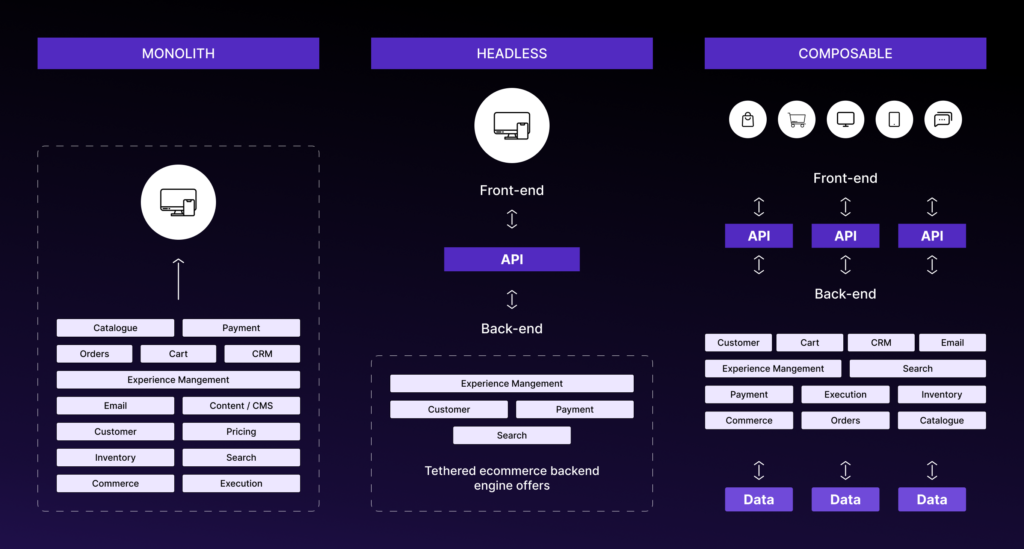The entire technological transformation has created new sales channels and marketplaces in the ecommerce domain, raising the overall competition level. Their current legacy systems don’t allow them to adapt to new trends quickly and often require heavy investment to incorporate new features to cater to customer needs.
The answer? Composable commerce. This agile and scalable approach allows companies to choose the best tools for each specific function, creating and managing exceptional shopping experiences. By migrating to composable commerce, businesses gain the flexibility and agility they need to stay on top of competition.
ON THIS PAGE
Steps to Migrate to Composable Commerce
- One of the main advantages of migrating to composable commerce is its flexibility to do so at your own pace.
- The microservice-based architecture allows you to decompose the monolithic structure into smaller functions, like checkout or shopping cart, and gradually replace these with individual components.

In this article, we will go through all the steps of the composable commerce migration process so that your business enjoys a smooth transition.
Step 1: Comprehensive Gap And Goals Analysis
The key steps to migrating to a composable commerce tech stack from the current monolithic platform are to identify future goals, such as better sales, enhanced and unique customer experiences, improved data integrity, and enhanced browsing experience.
You have to identify your company’s needs and analyze all the weaknesses. Also, you have to set aside the unused features to create a clear end solution. This involves analyzing your business capabilities, to remove the redundant ones and add the missing ones.
| Expert Tip: Always document all the objectives and use cases to ensure that everything is aligned with your future business strategy. This will allow you to analyze everything and provide a solid foundation for the entire migration process. |
Step 2: Select The Best-In-Breed Components For The New Stack
After analyzing all the necessary components, research everything and pick the best options for your new stacks.
Some of the top components will include an interactive storefront user interface, API orchestration layer, content management system, ecommerce platform, hosting, and the required third-party tools.
Step 3: Analyze The Investment: Overall Cost Analysis And Business Case Development
When you plan to migrate to composable architecture with a modular approach to handling future upgrades, consider the initial financial investment and potential return on investment.
The cost of software licenses will undoubtedly cut a major portion of your budget. Consider additional expenses, like the development approach, training of development teams, data migration services, and API development. These factors can easily increase the overall budget of the complete migration process.
Besides considering the overall cost, ensure you consider the long-term benefits of the process for future growth. Develop a business case that will include all the factors impacting the overall ROI.
- Higher operational efficiency due to scalable architecture.
- Better data integrity with modular architecture.
- Increased sales potential with a focus on the unique needs of customers.
Recommended Read: Top 13 Composable Commerce Examples
Step 4: Plan And Plot Your Migration Roadmap
Three key elements must be considered while planning the complete migration journey. Let’s discuss them in detail.
Data Migration And Modeling
- Reassess your organization’s goals for the online store to streamline the entire architecture.
- Remove the design and data components to enjoy greater flexibility and create a development environment that revolves around your future goals.
- Focus on the important data you need to migrate to the new architecture. This data will include end-user information, marketing material, multimedia content, etc.
- Modify the data if some sets are outdated or have no future value. Finally, export the data from the current system to a new platform using best practices to maintain proper data integrity.
Complete Your Ecosystem With The Best Available Components
- The option to select the best available components is one of the primary reasons for switching from monolithic architecture to a composable one.
- As you are no longer locked in with a single vendor, you can pick the best available options to develop your complete ecommerce ecosystem.
- The best components will play a crucial role in the future growth of your brand.
Prioritize The User Experience Of End-Users
- One of the main approaches of composable architecture gives you the ability to enjoy a headless back-end solution with which you can combine any front-end solution of your choice.
- Ensure that you cater to your customers’ robust needs, offering a personalized experience that will retain them in the long run.
Step 5: Implement Your Integration Strategy
You must integrate your decoupled front-end layers to meet customer needs. By switching to microservices-based architecture, your developers have the advantage of customization and higher flexibility.
You can opt for a phased migration and minimize the downtime to avoid immediate disruption. The migration process progresses in stages so you can easily make the adjustments and avoid several potential risks.
Besides this, focus on switching the critical functionality earlier to reap the benefits of the composable architecture quickly.
Step 6: Robust Testing For Seamless Integration
Once all the core functionalities are migrated to the new modular architecture, it is time to check the communication between all the components. Ecommerce testing is necessary as it allows you to address the potential issues before you go live with your ecommerce solution.
You may have to devise a testing plan for the components and analyze the success metrics. Ensure to include factors like the server’s response time, the webpage’s load time, and the transaction processing speed.
Try to make testing an ongoing process in which you identify issues proactively and deploy suitable measures to tackle them. Analyze all the testing results to identify areas for improvement and optimize your composable commerce architecture accordingly.
Step 7: Go Live After Successful Deployment
Review the content and ensure proper integration with your payment gateway so the customers can carry out the transaction smoothly. There shouldn’t be any broken links, and proper URL redirects should be implemented to improve your overall SEO ranking.
With these checks, you can go live without any unnecessary hassle and offer a lasting impression from the first day on your customers.
Step 8: Regular Maintenance And Post-Migration Support
Once the solution is deployed and your website is live, you must monitor and optimize it over time. Here are some key factors to consider.
- Ensure that your migration partner is tracking the performance metrics of the solution to identify the key areas for improvement. You can focus on those areas to optimize the solution and improve the overall user experience.
- Real-time monitoring is necessary to tackle any issues while the solution is live. Your migration partner should be able to offer proper support for all the issues.
- Finally, you should be able to analyze sales data, customer behavior, and product performance.
Read Also: 7 Best Composable Commerce Solutions
How Can A Business Migrate From A Monolithic System To Composable Architecture?
The best thing about transitioning from a legacy system to a composable commerce platform is that you can conduct the migration process at your own pace. There are two ways to shift from the traditional approach and enjoy the benefits of composable commerce architecture.
1. Phased Migration
In the phased migration, the transition takes place with a strangler pattern. In simple words, it refers to a step-by-step transition from the monolithic ecosystem to composable commerce architecture. The phased migration minimizes business disruption by offering some degree of business continuity.
Here is the breakdown of the complete migration process.
- Decoupling the front-end: This process begins with decoupling the front-end part from the back-end solution. It allows you to explore the composable storefront possibilities and get familiar with the perks of MACH architecture.
- Replace the components systematically: Now, the experts need to identify the critical functionalities of the current traditional model and focus on migrating them to the right composable commerce platform.
- Prioritize customer experience: You have to prioritize the migration of the components responsible for handling the customers. This includes the migration of specific components like product catalog.
- Integration and testing: As you start migrating the various components of the ecommerce system of your company, ensure that you create proper integration and testing routines. This approach will allow you to enjoy a smooth transition and identify any issues between the previous and new systems at the user interface and technical level swiftly.
2. Big Bang Approach
The second approach in the composable journey is to create a new modern tech stack alongside your existing monolithic data model. You can switch to the composable solution once the new tech stack is ready. Here is a quick breakdown of the complete process.
- Developing a new system in parallel: Develop a new architecture with the right composable commerce platform alongside your existing traditional architecture. This way, you can carry out the operations while creating a composable enterprise.
- Planning of data migration: The next step is to migrate data to the new system. Carefully identify all the data from the existing model and transform it into the new model for proper compatibility.
- Switch and go live: Once everything is tested and ready, you can make the final switch and enjoy the benefits of the new composable model.
Benefits of Composable Commerce Migration
The ecommerce domain has become an indispensable part of the global market. The trends are transforming and with the power of the latest technology, the entire process of selling and buying products and services is revamping.
| In 2024, ecommerce retail sales soared to 6.3 trillion US dollars, and they are expected to rise further in the next few years. Moreover, the US ranks at the top in retail ecommerce development, with a CAGR of 11.8%. |
Have a look at all the top benefits that composable commerce brings to different brands and retail businesses:
Flexibility & Agility
- Being cloud-native, composable commerce software offers high flexibility, speed, and the ability to handle great workloads.
- Owing to the personalized composable system, it promotes relentless growth by adapting to on-demand changes and market trends.
- You can easily add, switch, or remove different functionalities via modular iterations, enabling your business to stay highly responsive and agile.
Better Performance & Security
- Believe it or not, composable commerce is one of the best solutions when developing high-performance platforms.
- Owing to its composable structure, the site response times get quite low ensuring superb global reach.
- You are no longer dependent on a single server, you can easily experience highly secured site operations quickly.
Great Scalability
- With composable commerce, you get a chance to venture into numerous channels and explore new markets.
- You can easily experiment with different business models and grow your platform capabilities to handle traffic spikes and high-traffic demands without any hassle.
- You can unlock autoscaling that lets you capitalize on high-traffic occasions for high profits and customer satisfaction.
Quick Market Deployment
- When you use the modern approach of Composable Commerce, you allow businesses to outshine their competitors with faster updates and new features at a quicker pace.
- This happens by harnessing the pre-built commerce components that are well-tested and promise swift innovations backed by its agile approach.
- This also helps deliver your customers a fully personalized and engaging shopping experience.
Main Challenges In Composable Commerce Migration
Four key challenges hamper your composable commerce migration. Have a sneak peek at them below:
Integration Complexity
This is the main challenge faced in building a fully functional, cohesive system. Since integrating different components seamlessly requires intricate planning and expert knowledge of the architecture and platforms, the professionals need to align all components precisely.
Filling Skill Gaps
It is crucial to fill all skill gaps, as the new online store may entail new technology. You should identify any such knowledge gap and easily utilize the new platform to provide all innovations quickly.
Data Migration
You must know how difficult it is to transfer data from a monolithic approach system to a composable system. It is essential to safely transfer all data and maintain full data security and accessibility during the transition.
Change Management
Change management is required in different business processes and tasks with the adoption of the new commerce platform. So, it is important to undergo smooth change management to ensure all stakeholders and business users are well-informed and adopt the new technology seamlessly.
Composable Commerce Solutions From Klizer
The migration process to a composable commerce stack opens several new opportunities to improve the overall efficiency of your operations. So, you can future-proof your solution and make it more flexible and scalable. Klizer understands the need for custom solutions and offers superior composable commerce solutions that are built to cater to the needs of your audience.
Reach out for our excellent solutions for personalized shopping experiences and easy future update adaptation.
FAQ
What Is Composable Commerce?
Composable commerce is a modular approach in which you select the best options available for the components of your ecommerce solution and combine them to create a custom application or solution that revolves around your business’s specific needs.
The composable approach resembles the MACH technology, in which the decoupled microservice communicates through APIs (Application Programming Interface).
This approach increases the solution’s overall flexibility and scalability, allowing it to adapt to future changes smoothly without disrupting the entire system.
What is the Composable Commerce Architecture?
There are five main highlights of Composable commerce architecture:
- APIs are used for communication between multiple business functionalities.
- All services don’t share any single data store.
- Different business functionalities are deployed separately and can easily be scaled.
- Until APIs are exposed, all technologies to build the services do not matter.
- Storefront is entirely independent of different modules owing to headless services.
Why have brands and retail businesses started migrating to composable commerce?
Since the traditional monolithic approach didn’t allow rapid innovation, imparting flexibility and scalability became difficult. Designing custom solutions faster seems like a huge task.
Undertaking the modern approach of relying on composable commerce assures unparalleled customization and flexibility. This makes it easier for brands to scale up their business quickly. It also allows them to adapt to new technologies quickly and deliver better performance in their online stores.
Migrating to composable commerce software is a game-changer for brands aiming to be customer-centric, as it helps shape the full customer journey.






